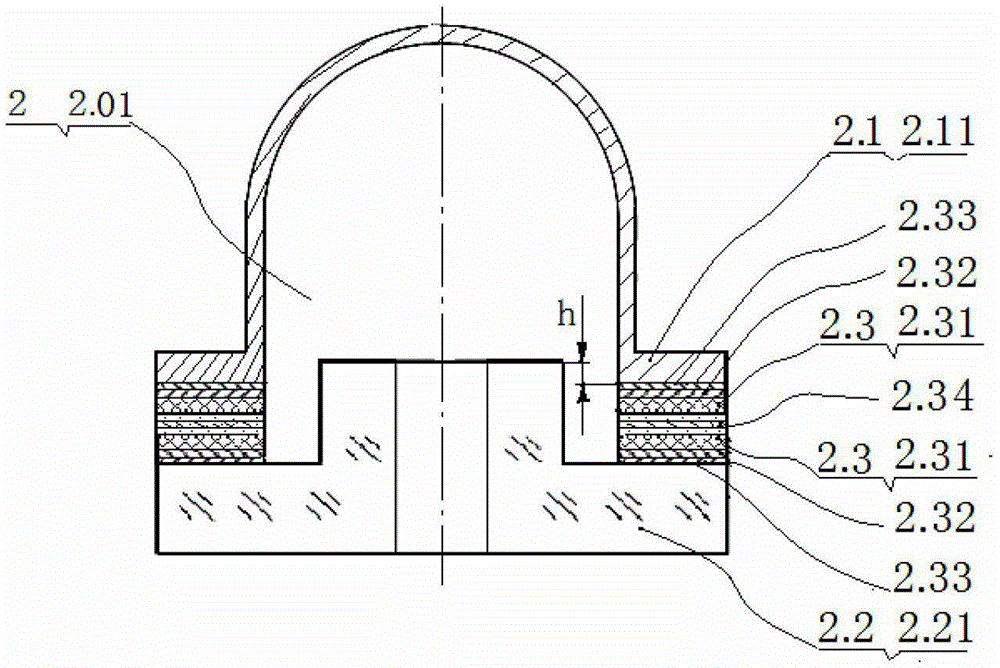Annular laser device with electrode group and manufacture method for electrode group
A technology of a ring laser and a manufacturing method, which is applied in the directions of lasers, laser parts, laser parts, etc., can solve the problems of long sealing method period, resonant cavity rupture, large thermal residual stress and deformation, etc., and achieves a simple manufacturing method. Reliable, easy to remove or replace, enhance serviceability
- Summary
- Abstract
- Description
- Claims
- Application Information
AI Technical Summary
Problems solved by technology
Method used
Image
Examples
Embodiment 1
[0040] Example 1: It is a basic embodiment of a ring laser with an electrode group according to the present invention. It includes a resonant cavity 1. The resonant cavity 1 includes an electrode group 2, an optical mirror 3 and a number of light-passing channels; the optical mirror 3 includes a beam splitter. Prism 3.1, light combining prism 3.2, reflecting mirror 3.3, E-shaped mirror 3.4; there is a detector 5 on the resonant cavity 1; the interior of the resonant cavity 1 is filled with helium-neon mixed gas; the electrode group 2 is composed of electrode conductor 2.1 It is formed by hot pressing connection with the glass ring 2.2 through the connection layer 2.3; the connection layer 2.3 is: the seed layer 2.33 deposited on the opposite sealing position of the electrode conductor 2.1 and the glass ring 2.2, and the seed layer 2.33 is deposited The transition layer 2.32, the active reaction layer 2.31 made on the transition layer 2.32, and the solder layer ring sheet 2.34 s...
Embodiment 2
[0041] Example 2: It is the preferred technical solution. The difference from Embodiment 1 above is that the anode electrode group 2.02 has a small anode electrode group 2.02' and a large anode electrode group 2.02''. The material of the glass ring 2.2 is the same as the material of the resonant cavity 1, mainly selected from glass-ceramic or silicon dioxide; the material of the electrode conductor 2.1 is a metal material.
Embodiment 3
[0042] Example 3: It is the preferred technical solution. The difference from Embodiment 1 above is that the materials of the seed layer 2.33 and the transition layer 2.32 are all metals. The active reaction layer 2.31 is a layered structure made of two or more materials with mixed negative calorific value through alternate evaporation of nano-films, or by screen printing of nano-particles. The material of the seed layer 2.33 is mainly Cr, the material of the transition layer 2.32 is mainly Au, and the material of the active reaction layer 2.31 is selected from two or more combinations of Al, Ni, Ti, Si, Nb and Mo. The material of the solder layer ring sheet 2.34 is high melting point solder, selected from gold-tin alloy solder, or tin-silver-copper alloy solder.
PUM
 Login to View More
Login to View More Abstract
Description
Claims
Application Information
 Login to View More
Login to View More - R&D
- Intellectual Property
- Life Sciences
- Materials
- Tech Scout
- Unparalleled Data Quality
- Higher Quality Content
- 60% Fewer Hallucinations
Browse by: Latest US Patents, China's latest patents, Technical Efficacy Thesaurus, Application Domain, Technology Topic, Popular Technical Reports.
© 2025 PatSnap. All rights reserved.Legal|Privacy policy|Modern Slavery Act Transparency Statement|Sitemap|About US| Contact US: help@patsnap.com



